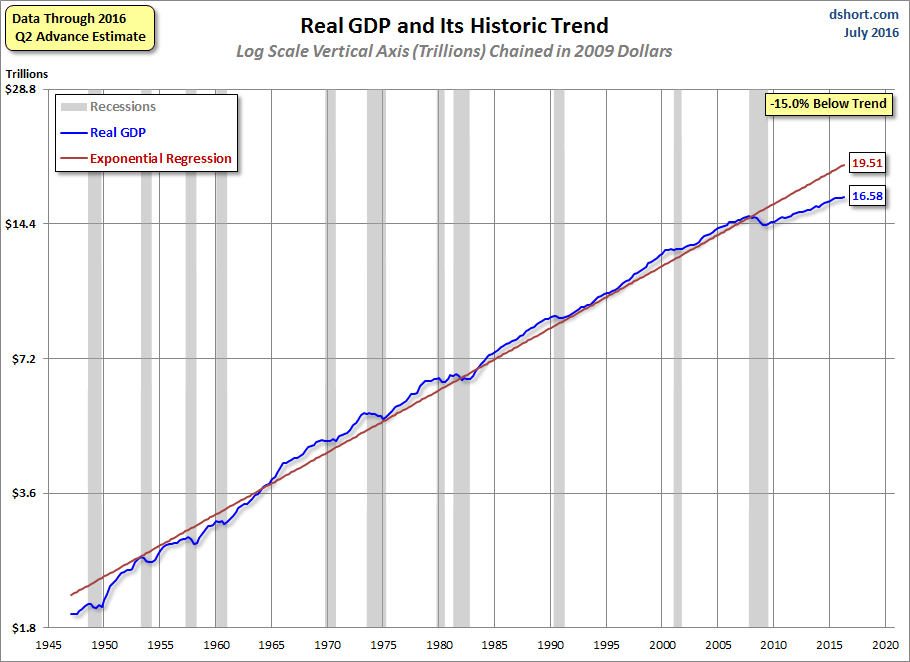GDP Q4 Advance Estimate: A Solid 3.2%
The Advance Estimate for Q4 GDP, to one decimal, came in at 3.2 percent. The GDP deflator used to calculate real (inflation-adjusted) GDP fell to 1.3 percent from 2.0 percent in Q3. Both the median and mean forecasts of the Wall Street Journal's latest survey of 49 economists had been for a lower 2.8 percent. Investing.com correctly forecast 3.2 percent.
Although the Q4 GDP of 3.2 percent is a decline from the Q3 4.1 percent, it is approximately at its long-term average of 3.3 percent, despite the economic stresses of the October government shutdown.
Here is an excerpt from the Bureau of Economic Analysis news release:
Real gross domestic product -- the output of goods and services produced by labor and property located in the United States -- increased at an annual rate of 3.2 percent in the fourth quarter of 2013 (that is, from the third quarter to the fourth quarter), according to the "advance" estimate released by the Bureau of Economic Analysis. In the third quarter, real GDP increased 4.1 percent.
The Bureau emphasized that the fourth-quarter advance estimate released today is based on source data that are incomplete or subject to further revision by the source agency (see the box on page 4 and "Comparisons of Revisions to GDP" on page 5). The "second" estimate for the fourth quarter, based on more complete data, will be released on February 28, 2014.
The increase in real GDP in the fourth quarter primarily reflected positive contributions from personal consumption expenditures (PCE), exports, nonresidential fixed investment, private inventory investment, and state and local government spending that were partly offset by negative contributions from federal government spending and residential fixed investment. Imports, which are a subtraction in the calculation of GDP, increased.
The deceleration in real GDP in the fourth quarter reflected a deceleration in private inventory investment, a larger decrease in federal government spending, a downturn in residential fixed investment, and decelerations in state and local government spending and in nonresidential fixed investment that were partly offset by accelerations in exports and in PCE and a deceleration in imports.
The price index for gross domestic purchases, which measures prices paid by U.S. residents, increased 1.2 percent in the fourth quarter, compared with an increase of 1.8 percent in the third. Excluding food and energy prices, the price index for gross domestic purchases increased 1.7 percent in the fourth quarter, compared with an increase of 1.5 percent in the third. [Full Release]
Here is a look at GDP since Q2 1947 together with the real (inflation-adjusted) S&P Composite. The start date is when the BEA began reporting GDP on a quarterly basis. Prior to 1947, GDP was reported annually. To be more precise, what the lower half of the chart shows is the percent change from the preceding period in Real (inflation-adjusted) Gross Domestic Product. I've also included recessions, which are determined by the National Bureau of Economic Research (NBER).
Here is a close-up of GDP alone with a line to illustrate the 3.3 average (arithmetic mean) for the quarterly series since the 1947. I've also plotted the 10-year moving average, currently at 1.7. The current GDP is now nearly double this moving average and just 0.1 percent below its long-term average.
Here is the same chart with a linear regression that illustrates the gradual decline in GDP over this timeframe.
Perhaps the most telling representation of slowing growth in the US economy is the year-over-year rate of change. The latest data point at 2.74 percent is off its interim low of 1.32 percent in Q1.
And for a bit of political trivia, here is a look at GDP by party in control of the White House and Congress.
In summary, the Q4 GDP Advance Estimate of 3.2 percent met or beat most economists' forecasts and will be seen as a confirmation of the Fed's decision to taper its asset purchases.
© Copyright 2013, Advisor Perspectives, Inc. All rights reserved.








